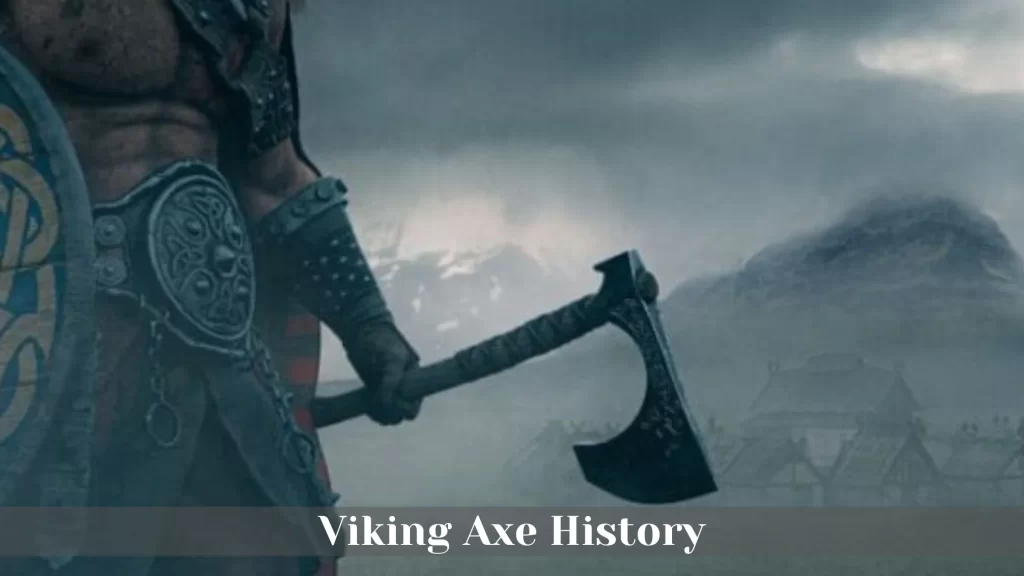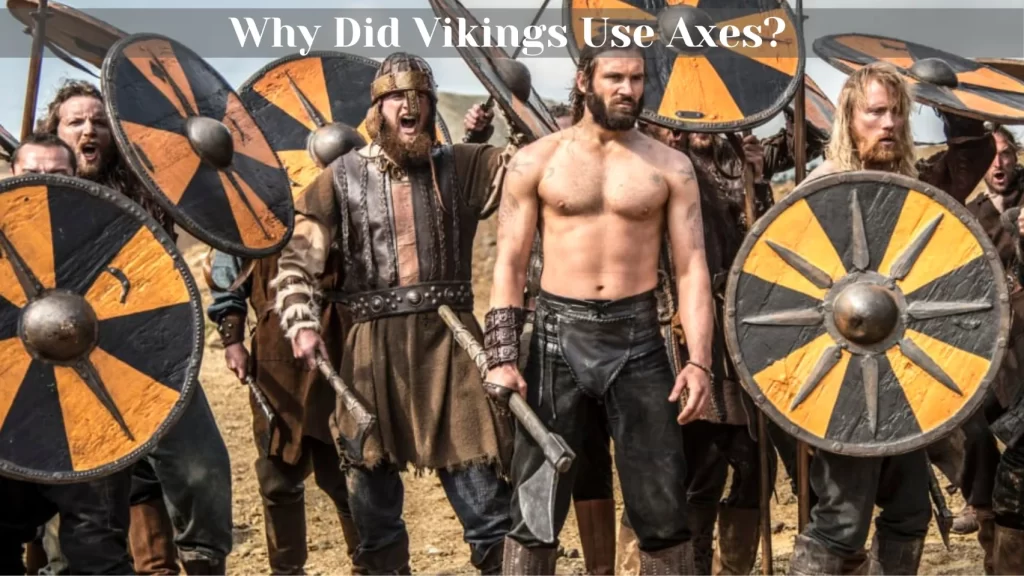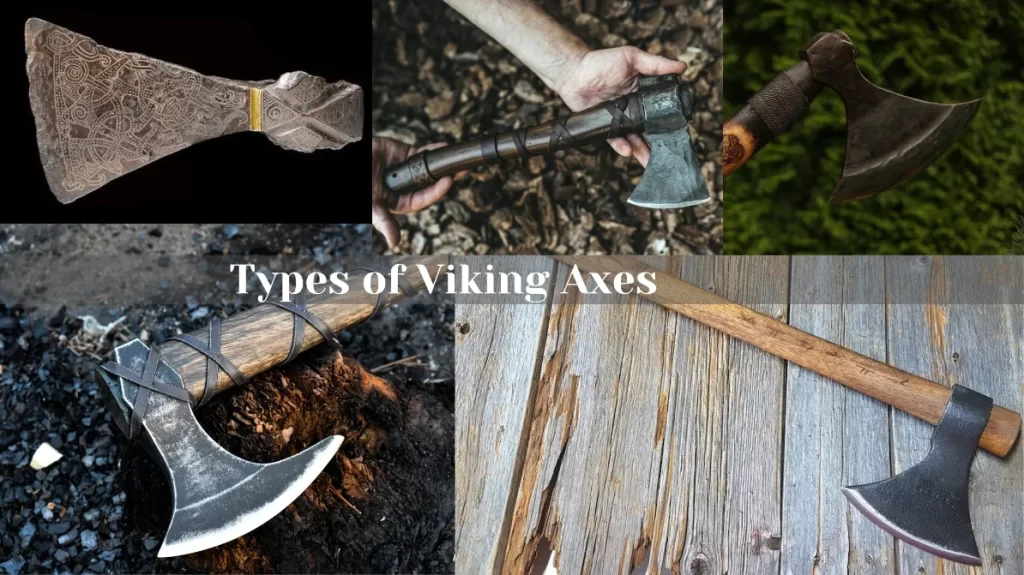Viking Axe was the most feared iconic weapon and versatile tool of Norse people between 600 to 1200 CE. It was evolved from earlier Germanic and Nordic axe designs. Historical facts show that a Viking was a versatile tool for everyday tasks initially, and a deadly weapon for raiding and fighting. But later on, it became a symbol of power, status, and identity.
The Viking axe has a long and rich history, dating back to the prehistoric period. Viking warriors were known for their fierce and brutal fighting style, and the axe was their weapon of choice.
In this blog post, we’ll go back in time to see the Viking axe history, and how axes shaped the lives and legends of the Norse people. We’ll also explore the stories behind this legendary axe, from its beginnings in the Viking Age to its importance in today’s modern world.

Contents
History of the Viking Axe
The Viking axe had a long and rich history, rooted in the Iron Age that began in Scandinavia around 500 BC. But it was during the Viking Age (793-1066 CE) that the Viking axes reached their peak of development and use.
The earliest Viking axes were simple tools with a single-edged blade and a wooden haft. They were used for a variety of purposes, including woodworking, carpentry, and hunting. However, by the 9th century AD, Viking axes had become more specialized and developed into formidable weapons of war.
One of the most common types of Viking axes was the Dane axe. The Dane axe had a broad blade that was perfect for cleaving through armor and shields. Another common type of Viking axe was the bearded axe. The bearded axe was shorter, more versatile axe that could be used for both combat and everyday tasks.
Read about how did Vikings make their axes from the historical and archeological evidences.
Symbolism and Significance of Viking Axe in Norse Culture and Mythology
It is clear from the historical evidences that the axe was not only a practical tool and weapon for the Vikings, but also a symbol of their culture and identity. The axe represented strength, courage, and honor, and it was a sign of a warrior’s status and skill.
The Vikings often personalized and decorated their axes with carvings, inlays, or runes, and some axes had names or inscriptions. The axe was also a sacred object, as it was associated with some of the most powerful and revered gods and goddesses in Norse mythology, such as:
Thor
The god of thunder, lightning, and storms, who wielded the mighty hammer Mjölnir, which was often depicted as an axe-like weapon. Thor was the protector of the gods and humans, and he used his hammer to fight the giants and the forces of chaos. Thor’s hammer was also a symbol of fertility, and it was often worn as a pendant by the Vikings.
Odin
The god of wisdom, war, and poetry, who carried the spear Gungnir, which was also sometimes shown as an axe-like weapon. Odin was the leader of the gods and the ruler of Asgard, the home of the gods. Odin was also the god of the dead, and he received half of the slain warriors in his hall of Valhalla, where they prepared for the final battle of Ragnarök, the end of the world.
Freyja
The goddess of love, beauty, and fertility, who owned a sword called Brísingamen (made of pure gold), which was also sometimes depicted as an axe-like weapon. Freyja was the most beautiful and desirable of the goddesses, and she was also a powerful sorceress and a warrior.
Freyja was also the goddess of the dead, and she received the other half of the slain warriors in her hall of Sessrúmnir, where they enjoyed eternal bliss.
Sif
Also, the goddess Sif, known for her golden hair and fertility in Norse history, was often depicted holding an axe, which symbolized her connection to agriculture and the cycles of life and death.
Archaeological Findings and Literary Sources
There is a wealth of archaeological evidence that attests to the importance of the axe in Viking society. Axes have been found in Viking graves, hoards, and settlements all over Scandinavia and Northern Europe. Some of the most famous archaeological finds include the Mammen axe, the Gjermundbu axe, and the Oseberg axe.
The Mammen axe, which was found in a magnate’s grave in Mammen, Denmark, dating from around 970 AD. The Mammen axe is one of the most elaborate and beautiful axes ever made by ancient craftsmen, and it is decorated with silver inlay that features both Christian and pagan motifs, such as a tree, a bird, and an animal figure. It is believed to have belonged to a high-ranking Viking warrior.
The Gjermundbu axe is another richly decorated axe that was found in a Viking grave in Norway. The axe is decorated with silver and bronze inlays, and it is believed to have belonged to a wealthy Viking merchant.
And, the Oseberg ship burial, which was discovered in Oseberg, Norway, dating from around 834 AD. The Oseberg ship burial is one of the most impressive and well-preserved Viking burials ever found, and it contained the remains of two women, one of whom was probably a queen or a priestess. The Oseberg ship burial also contained a large number of grave goods, including several axes, some of which were decorated with carvings or metal fittings. The axes were believed to have been used for both ceremonial and practical purposes.
In addition to archaeological evidence, there is also a wealth of literary evidence that attests to the importance of the axe in Viking culture. The Icelandic sagas, which are a collection of epic stories about the Vikings, are full of references to the axe. In the sagas, the axe is often depicted as a symbol of strength, courage, and honor.
How Viking Axes Became Famous on the Battlefield
The axe was Vikings’ most effective weapons on the battlefield, as it could be used for various purposes and situations. Viking axes were a formidable weapon on the battlefield. They could be used to hack through armor, cleave through shields, and deliver devastating blows to the head and neck.
The axe was especially suited for the Viking style of warfare, which was fast, fierce, and fearless. The Vikings relied on surprise, speed, and shock to overwhelm their opponents, and they often used hit-and-run tactics, ambushes, and raids. The axe was a light and agile weapon, which allowed the Vikings to move quickly and strike hard.
The Viking axe could be used as a melee weapon, for close combat and duels, or as a missile weapon, for throwing at a distance. Best of all, Norsemen used the battle axe for breaking down doors, walls, and barricades, and also used it as a shield, for blocking or parrying attacks.
Read about the most expensive Viking weapon. And guess what? It’s not an axe!
Influence of The Viking Axe in Modern Times
In the present day, the Viking axe is not just a relic of the past; it lives on in the hands of woodworkers, carpenters, and reenactors. Its design, which has stood the test of time, is appreciated for its practicality and aesthetics. It is also a popular collector’s item, for the people who love the ancient craftsmanship and forging.
We also see a lot of dual-edged axes now in movies and series, but did Vikings actually use double-bladed axes to fight battle?
Wrapping Up
The Viking axe is one of the most iconic weapons in history. It was feared by enemies and admired by allies alike for its power and versatility. The Viking axe was used as a deadly weapon in battle, as a versatile tool for everyday tasks, and as a religious symbol. It played an important role in Viking culture and society.
Throughout our exploration of Viking axe history, we’ve witnessed its early origins, its role in Norse culture and mythology, and its remarkable impact on the battlefield. We’ve delved into the legends of Thor’s Mjölnir, Odin’s Gungnir, and Freyja’s enchanting axe. These myths remind us of the intertwining of the divine and the mortal in Viking culture.
Frequently Asked Questions
What is the history of the Nordic axe?
The history of the Nordic axe, specifically the Viking axe, dates back to the early medieval period, during what is commonly referred to as the Viking Age. This iconic weapon evolved from simpler designs and became a quintessential element of Viking culture and warfare. It was used both as a tool for everyday tasks and as a formidable weapon.
What does a Viking axe symbolize?
A Viking axe symbolizes a range of qualities and attributes, deeply rooted in Norse culture and mythology. It represents strength, courage, and the indomitable spirit of the Vikings. Beyond its utility, the Viking axe is associated with divine power, often linked to gods and goddesses such as Thor and Odin. It embodies both the creative and destructive forces, and it serves as a symbol of protection and fearlessness.



